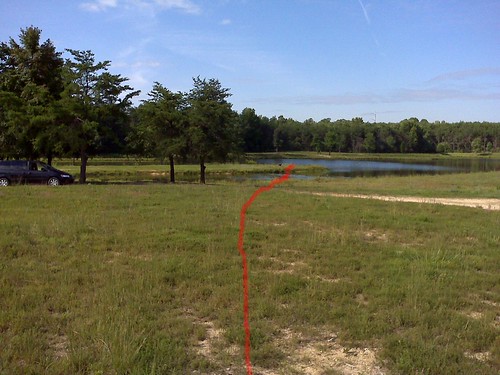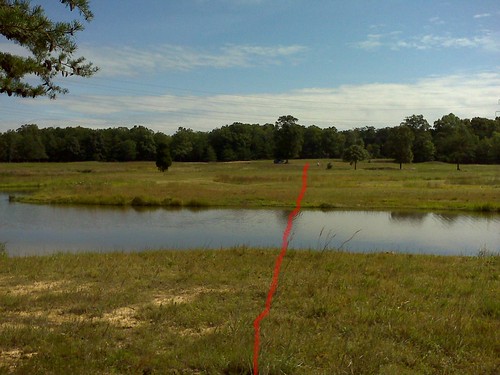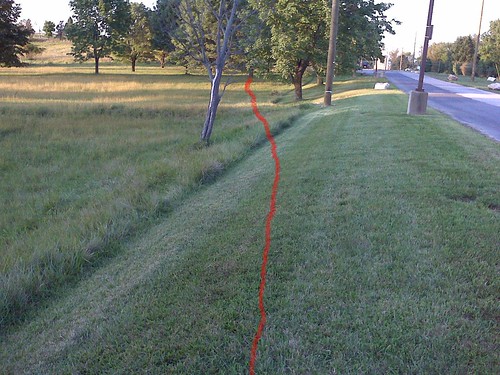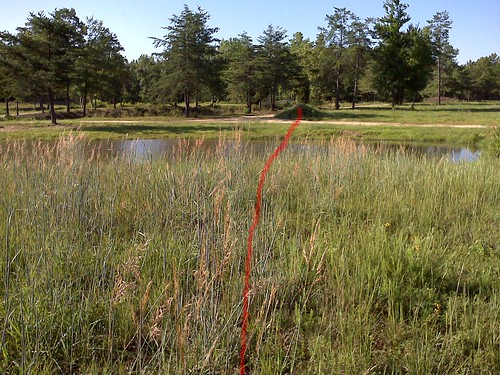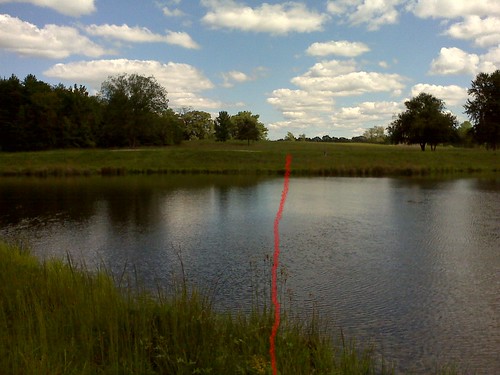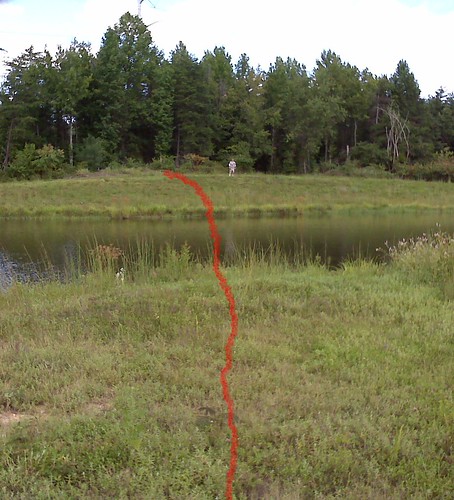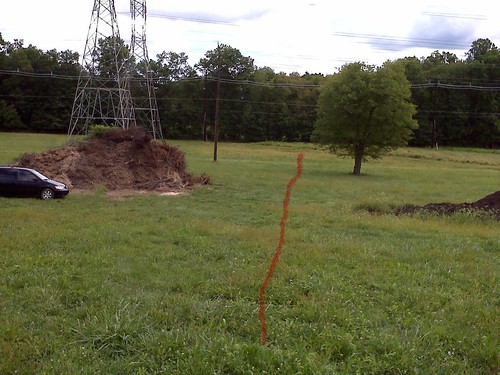Today was a group training day at Cheltenham. Lumi, Laddie and I arrived early and ran Series A ourselves, and Gaby joined us and also had Buster run Series A. Then we all ran Series B and C with the group. When group training was over, Gaby and I took our dogs over to the big pond and ran some more retrieves designed for specific dogs. For Lumi and Laddie, that was Series D and E. On our way home, I stopped at the Oaks fields near home and ran Laddie on Series F in Oaks Area 2.
Cheltenham
SERIES A. Land blind (Laddie, then Lumi)
This was a 150-yard blind, on a line similar to one Lumi and Laddie have run at least once before. The line to the blind was across a marshy area, then uphill and thru a keyhole formed by a tree and a mound. The blind was planted near the top of a rise.
Photo from Series A

Series A 150-yard blind
SERIES B. Land double and blind (Laddie, then Lumi)
The memory-bird (duck) of the converging double was on the left, thrown with a winger left to right at 90 yards. The go-bird (duck) was 90° to the right, thrown with a winger right to left at 50 yards. Duck calls and gunshots were used for both marks.
The blind (OD) was at 40 yards, on a line 15° to the right of the right throwing station and placed just inside the edge of a wooded area.
The following photos are in the order the retrieves were run.
Photos from Series B

Series B 50-yard go-bird

Series B 90-yard memory-bird

Series B 40-yard blind
SERIES C. Water double and blind (Laddie, then Lumi)
The memory-bird (duck) of the converging double was on the left, thrown with a winger left to right at 70 yards. The go-bird (duck) was 135° to the right, thrown with a winger from behind the SL, right to left across a narrow channel at 20 yards. Duck calls and gunshots were used for both marks. The go-bird was intended as a "breaking bird", meaning that the dog would have a strong tendency to break rather than waiting until sent. As a precaution, I held my dogs' tabs when the marks were being thrown, but neither attempted to break.
For Laddie, the go-bird duck splashed into the channel. For Lumi, it landed in the marsh on the far shore and immediately sank out of sight. Lumi swam across, climbed on shore, and stuck her face down into the water and grass to get the bird. She then dropped it on solid ground, shook off, picked it back up, and completed the retrieve. It didn't look easy finding and retrieving that bird, so I was pleased with her work on that mark.
The surprisingly difficult blind (OD) was at 40 yards, placed just inside an area of high cover a few feet to the left of the left throwing station. Intending to avoid unnecessary difficulty this close to a test (Lumi and Laddie are entered in a Senior text next Sunday), I ran them from a point along the shore closer to the blind, rather than from the original SL.
It turned out, however, that the primary difficulty for the blind seemed to be the placement of the dummy so close to the throwing station and just inside the area of high cover. Laddie ran right over the dummy and sat when I whistled, but since he was by then well into the high grass, he would not take a come-in cast, either because of poor visibility or because he did not believe that my cast would bring him closer to the blind. As he continued to refuse casts and got further and further from the blind, he was out of sight most of the time, and slipped whistles or refused casts repeatedly when he did become visible. He eventually swam across an inlet on the far side of the peninsula and began to hunt in the large area of high cover on the other side.
Interestingly, one of the other trainers had her Master dog, who is trained by a local pro, run almost the identical behavior sequence a short time later. It was helpful for me to see that even a dog known to be accomplished and well-trained could behave exactly as Laddie had in that situation.
One difference was that during her turn, the other trainer walked out, eventually getting right in front of the blind, and painstakingly handled her dog until he finally picked up the dummy. I was getting flack from one of the other trainers when Laddie went OOC, and the guy actually called another dog to the line while I was still walking out toward Laddie, so I didn't have the opportunity to have Laddie complete the retrieve.
When Lumi's turn came up, the guy told me I couldn't have Lumi run the blind until the other dogs had finished their turns. I insisted that we were preparing for a test and that she was going to run the blind after the double, and with the staunch support of one of the other trainers, I prevailed. When it was time for Lumi to run the blind, I was extra cautious. After she crossed the water, I stopped her at water's edge, cast her back, and then used the whistle again to stop her as soon as she got near the blind. Though she was even closer to the blind when she stopped than Laddie or the other dog had been when they stopped, Lumi, too, had difficulty spotting the dummy nestled in high cover only a yard or two in front of her.
The following photos are in the order the retrieves were run.
Photos from Series C

Series C 20-yard go-bird

Series C 70-yard memory-bird

Series C 40-yard blind
SERIES D. Water blind (Laddie, then Lumi)
This was a 130-yard LWL blind (OD). After Laddie and Lumi ran it, Gaby also ran Buster on this one. The line to the blind was from a few yards back from an angle entry, across a 30-yard channel, up an embankment, diagonally across a dirt road, diagonally thru several strips of high cover and past a large tree on the left, to the blind planted just inside a wedge of high cover. We did not use an LP but we did have a length of orange ribbon tied to grass at the location of the blind.
My intent was that the dogs would require handling on the far shore after they crossed the water, since that's something I want to work on with them, but none of the dogs required much handling.
SERIES E. Water blind (Laddie, then Lumi)
This was a 70-yard blind (OD), with a 50-yard shoreline swim and the blind placed on the hillside on the far side, requiring a diagonal uphill climb. Again, I wanted to focus on far-shore handling, but little handling was required.
Oaks Area 2
SERIES F. Double land blind (Laddie only)
To give Laddie a little more practice handling, I had him run two more blinds at a field near home. Although the blinds required running thru high cover and among trees, they did not present the factors of water and having other trainers around, which I think may be more important challenges for Laddie at this time.
In any case, the first blind (OD) was to the right at 80 yards. The second blind (OD) was 90° to the left at 120 yards.
Photos from Series F

Series F 80-yard blind
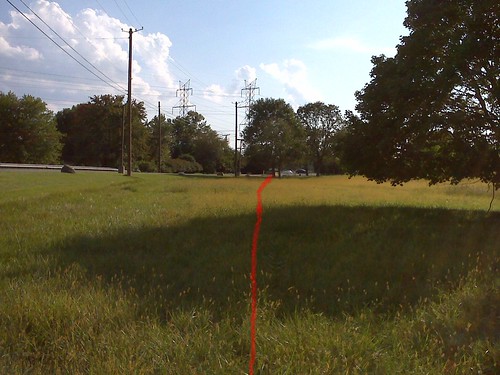
Series F 120-yard blind
